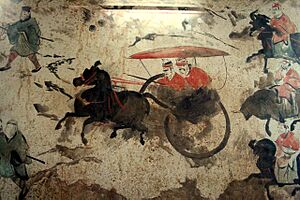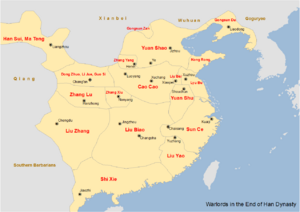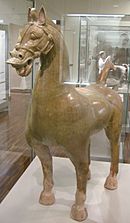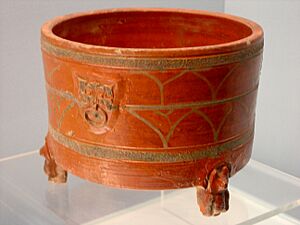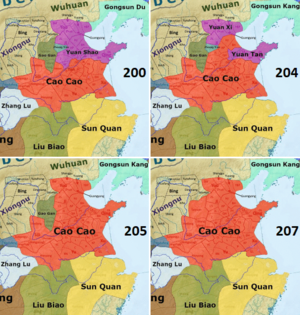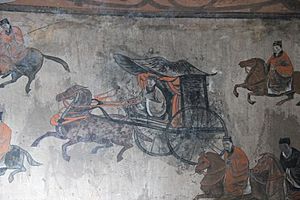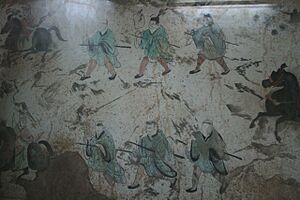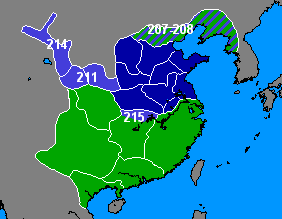End of the Han dynasty facts for kids
Quick facts for kids End of the Han dynasty |
|||||||
|---|---|---|---|---|---|---|---|
| Traditional Chinese | 漢朝末年 | ||||||
| Simplified Chinese | 汉朝末年 | ||||||
|
|||||||
| End of the Eastern Han dynasty | |||||||
| Traditional Chinese | 東漢末年 | ||||||
| Simplified Chinese | 东汉末年 | ||||||
|
|||||||
The end of the Han dynasty was a time of great change in Chinese history. It lasted from 189 to 220 CE. This period saw the last Han ruler, Emperor Xian, on the throne. After this, China entered the Three Kingdoms era (220–280 CE).
During this time, China faced many problems. A big uprising called the Yellow Turban Rebellion (184–205) caused much trouble. Also, a powerful warlord named Dong Zhuo took control of the emperor and destroyed the government. This led to the country breaking into many smaller regions, each ruled by different warlords.
One important warlord, Cao Cao, gained control of Emperor Xian in 196. He then began to bring the empire back together. Cao Cao acted as if he was serving the emperor, but Emperor Xian was actually his hostage. Cao Cao tried to unite all of China, but his armies were defeated at the Battle of Red Cliffs in 208-209. Here, he lost to the combined forces of Sun Quan and Liu Bei.
The Han dynasty officially ended in 220. Cao Cao's son, Cao Pi, made Emperor Xian step down from the throne. Cao Pi then started a new state called Cao Wei. Because of this, Liu Bei declared himself emperor of Shu Han in 221. Later, Sun Quan also became emperor of Eastern Wu in 229. This period, from 220 to 280 CE, is known as the Three Kingdoms era.
Contents
How the Government Collapsed (184–191)
The Yellow Turban Rebellion and Local Power (184–189)
Towards the end of Emperor Ling of Han's rule (168–189), many officials worried about the future. They saw that local revolts, like the big Yellow Turban Rebellion in 184, were happening because local officials didn't have enough power.
So, Emperor Ling changed the titles of local "Inspectors" to "Governors." He gave them more power to collect taxes and lead armies in their areas. This change meant that these provincial governors became very strong. They later became the warlords who controlled large parts of the Han empire.
The Fight for Imperial Power (189)
Emperor Ling died in 189. His 13-year-old son, Liu Bian, became Emperor Shao. The emperor's mother, Empress He, became the ruler for her young son. Her brother, General-in-Chief He Jin, became the most powerful person in the court.
He Jin and another official, Yuan Shao, planned to get rid of the "Ten Attendants." These were powerful eunuchs (court officials) who had too much influence. But Empress Dowager He didn't agree with their plan.
He Jin then called Dong Zhuo, a strong warlord, to march to the capital city, Luoyang. He hoped Dong Zhuo would force the Empress Dowager to remove the eunuchs. But the eunuchs found out about the plan. They tricked He Jin into the palace and killed him on September 22, 189. In response, Yuan Shao led soldiers to kill many eunuchs in the palace.
The remaining eunuchs kidnapped Emperor Shao and his younger brother. They tried to escape but ended up in the Yellow River. Dong Zhuo arrived and found the young emperor and his brother. The emperor was scared, but his younger brother, Prince of Chenliu, was calm. Dong Zhuo used this chance to take control of the government. He brought his army into the capital. Soon after, Dong Zhuo removed Emperor Shao from the throne and poisoned him. He replaced him with the Prince of Chenliu, who became Emperor Xian. Dong Zhuo became the most powerful person in the court, acting like a king.
Fighting Against Dong Zhuo (189–191)
In 190, several warlords formed a group against Dong Zhuo. They said he was trying to take over the throne and had kidnapped Emperor Xian. Yuan Shao was chosen to lead this group. Their armies gathered, ready to attack Luoyang.
However, the group was not well organized. They were also afraid to fight Dong Zhuo's strong army directly. Dong Zhuo, feeling worried, decided to move the capital to Chang'an in the west. He forced Emperor Xian and all the people of Luoyang to move with him. He then ordered Luoyang to be burned down.
In 191, the warlords tried to make Liu Yu, a member of the royal family, the new emperor. But Liu Yu stayed loyal to Emperor Xian and refused. While the warlords argued, a general named Sun Jian attacked Dong Zhuo near Luoyang. Sun Jian won several battles and forced Dong Zhuo to retreat to Chang'an. Luoyang then came under the warlords' control.
After this, the warlords stopped fighting Dong Zhuo and eventually broke up. Many officials started thinking about ruling their own territories like kings. Important warlords who became powerful included:
- Yuan Shao, who took control of Ji Province (parts of Hebei and Henan).
- Liu Yan, who controlled Yi Province (Sichuan Basin).
- Liu Biao, who controlled Jing Province (Hubei and Hunan).
- Yuan Shu, Yuan Shao's half-brother, who controlled areas south of the Huai River (Anhui).
Soon, the entire Han empire broke into many small areas, each controlled by a local warlord.
Dong Zhuo's Death and More Wars (192–196)
Dong Zhuo's Death (192)
After moving to Chang'an, Dong Zhuo became even more controlling. He was cruel to anyone who disagreed with him. Some officials, including Wang Yun, secretly planned to kill him. They convinced Dong Zhuo's adopted son, Lü Bu, to join them. Lü Bu disliked Dong Zhuo because Dong Zhuo had once tried to kill him.
In May 192, Lü Bu and Wang Yun killed Dong Zhuo and his family. People thought the chaos would end and the government would return to normal. However, Wang Yun made mistakes. He didn't get along with Lü Bu and refused to forgive Dong Zhuo's remaining followers. This made Dong Zhuo's men afraid they would be killed.
Dong Zhuo's son-in-law, Niu Fu, took control of Dong's army. When Niu Fu died, his officers, Li Jue, Guo Si, and Fan Chou, wanted to surrender to the emperor. But Wang Yun refused to forgive them. So, Li Jue, Guo Si, and Fan Chou attacked Chang'an. They took control of the government. Wang Yun was captured and killed, and Lü Bu was defeated and fled.
Continued Fighting (193–196)
After taking over the court in Chang'an, Li Jue, Guo Si, and Fan Chou did whatever they wanted. Meanwhile, warlords across China fought each other to gain more land. Some were friendly with Li Jue, while others were not, even though they all still said Emperor Xian was their ruler.
In 195, Li Jue and Guo Si started fighting each other. Li Jue held Emperor Xian hostage, while Guo Si kidnapped imperial officials. Both sides battled. Later, they made peace and let Emperor Xian return to the old capital, Luoyang. But they soon changed their minds and chased him. They couldn't catch him again, but the imperial court was left poor and helpless. Luoyang had been destroyed by Dong Zhuo, so there was no food or supplies. Many officials starved.
Around this time, Yuan Shao's advisor suggested he bring Emperor Xian to his territory. This would let Yuan Shao control the government. But Yuan Shao's other advisors disagreed. They said if the emperor came, Yuan Shao would have to follow strict court rules. Yuan Shao couldn't decide what to do.
Cao Cao Unites the North (196–207)
Cao Cao Uses Emperor Xian's Power
While Yuan Shao was still thinking, Cao Cao quickly brought the emperor to his own land. At this time, Cao Cao was not a very powerful warlord. He only controlled Yan Province (parts of Shandong and Henan). In 196, Cao Cao led his army to Luoyang. He convinced the officials protecting Emperor Xian that he was loyal.
Cao Cao then escorted the emperor to his base in Xu (present-day Xuchang, Henan), making it the new capital. From then on, Cao Cao held the real power, even though he was officially a subject of Emperor Xian. He always treated the emperor with respect. Cao Cao also issued orders in Emperor Xian's name to other warlords. This made it seem like they were obeying the emperor, but they were actually obeying Cao Cao. Yuan Shao realized too late that he had missed a big chance to control other warlords.
Cao Cao's Rise to Power (196–199)
Even in the new capital, the government lacked money and food. Cao Cao started a new farming plan called tuntian. Soldiers grew crops, and the harvest was shared. This plan worked very well. The area around Xu became very productive, solving the food shortage.
At this time, the main warlords were:
- Yuan Shao, who controlled most of Hebei, Shanxi, and Shandong.
- Yuan Shu, who controlled most of Anhui and parts of Jiangsu.
- Gongsun Zan, who controlled You Province (Beijing, Tianjin, Liaoning).
- Liu Biao, who controlled Jing Province (Hubei and Hunan).
- Liu Zhang, who controlled Yi Province (Sichuan Basin).
- Lü Bu, who took Xu Province (northern Jiangsu) from Liu Bei.
Cao Cao worked to make these warlords submit to him. In 197, Zhang Xiu surrendered to Cao Cao. But Zhang Xiu rebelled and attacked Cao Cao, killing Cao Cao's eldest son and bodyguard. Cao Cao barely escaped. Later, Zhang Xiu surrendered again. Cao Cao also convinced Ma Teng and Han Sui, who controlled Shaanxi and Gansu, to join him.
That year, Yuan Shu declared himself "Son of Heaven." This was seen as treason against the Han dynasty. Other warlords attacked him. Sun Ce, son of Sun Jian, who had taken over lands in Jiangdong, broke his alliance with Yuan Shu. Lü Bu also turned against Yuan Shu and defeated him. Cao Cao also attacked and defeated Yuan Shu. Yuan Shu died of illness in 199.
In 198, Yuan Shao tried to get Cao Cao to move the capital closer to his own territory, hoping to take Emperor Xian. But Cao Cao refused. Later that year, Cao Cao and Liu Bei attacked Lü Bu. They defeated him at the Battle of Xiapi. Lü Bu was killed, and Xu Province came under Cao Cao's control.
In 199, Gongsun Zan was defeated by Yuan Shao. Yuan Shao took all of Gongsun Zan's lands. Yuan Shao then turned his attention to Cao Cao, who was becoming very powerful. Yuan Shao allied with Liu Biao and planned to attack Cao Cao.
The Guandu Campaign (200–201)
Yuan Shao prepared to attack Cao Cao, even though his advisors said his troops were tired. Yuan Shao was sure his much larger army could easily defeat Cao Cao. While Cao Cao got ready, he found out that Dong Cheng, Liu Bei, and others were plotting against him.
In early 200, Liu Bei broke away from Cao Cao and took control of Xu Province. Dong Cheng and others planned to kill Cao Cao, but their plot was discovered. All the plotters and their families were killed. Cao Cao then took a risk and attacked Liu Bei in Xu Province. This left his own lands open to attack from Yuan Shao. But Cao Cao was right; Yuan Shao didn't attack. Liu Bei was defeated and fled to join Yuan Shao. Liu Bei's general Guan Yu surrendered to Cao Cao for a time.
Only after Liu Bei's defeat did Yuan Shao begin his attack. His advisor said it was too late, but Yuan Shao ignored him and had him imprisoned. Yuan Shao's generals, Yan Liang and Wen Chou, were killed in battles against Cao Cao's forces. This greatly hurt the morale of Yuan Shao's army.
By late 200, Yuan Shao and Cao Cao's armies met at Guandu (in present-day Zhengzhou, Henan). Yuan Shao had more soldiers and supplies, but Cao Cao's troops were better trained. After some small fights, both sides were stuck. Then, Cao Cao led a small group on a surprise attack on Yuan Shao's supply base at Wuchao. Yuan Shao sent troops to attack Cao Cao's main camp instead of helping Wuchao. This failed. The fall of Wuchao was a huge blow to Yuan Shao's army. They were then completely defeated by Cao Cao. Yuan Shao fled north, and most of his soldiers were killed or surrendered. From then on, Yuan Shao was no longer a major threat to Cao Cao. Cao Cao defeated Yuan's remaining troops, ending the Guandu campaign.
The Fall of the Yuan Family (202–207)
After Yuan Shao died in 202, his oldest son Yuan Tan and third son Yuan Shang fought over who would take over. Yuan Shao had divided his lands among his sons and nephew, hoping to see who was best. But he didn't clearly name a successor. This led to a fight between Yuan Tan and Yuan Shang.
Cao Cao used this family quarrel to his advantage. He attacked the Yuans, who retreated. Cao Cao then pretended to withdraw his forces. His advisor said that if Cao Cao left, the Yuan brothers would fight among themselves. This prediction came true. Yuan Tan attacked Yuan Shang. Yuan Shang fled. Yuan Tan then asked Cao Cao for help. Cao Cao attacked Yuan Shang, forcing him to retreat.
In 204, Cao Cao attacked Yuan Shang's base at Ye. Yuan Shang was defeated and fled. Cao Cao took Ye. Yuan Tan then tried to take Yuan Shang's lands. Cao Cao accused Yuan Tan of breaking their alliance and attacked him. Cao Cao captured Yuan Tan's last stronghold and killed him.
Meanwhile, Yuan Shang and his brother Yuan Xi fled further north to join the Wuhuan tribes. Another Yuan relative, Gao Gan, rebelled against Cao Cao but was defeated and killed. In 207, Cao Cao's army attacked the Wuhuan tribes and defeated them. Yuan Xi and Yuan Shang tried to find safety with another warlord, but he had them killed and sent their heads to Cao Cao. By this time, the Yuan family was gone, and most of northern China was united under Cao Cao.
Events in Southern China (194–208)
While Cao Cao was uniting the north, he didn't launch major attacks on the south. He waited for the right moment to deal with the other powerful warlords: Sun Quan (who took over after his brother Sun Ce died in 200), Liu Biao (governor of Jing Province), and Liu Zhang (governor of Yi Province).
Sun Quan was busy building up his lands and army in Jiangdong. In 208, Sun Quan defeated and killed Liu Biao's general, taking much of his territory. Meanwhile, Liu Bei had fled south and joined Liu Biao. Liu Biao placed Liu Bei near the northern border to keep Cao Cao away. An early attack by Cao Cao on Liu Bei was stopped in 202.
The Red Cliffs Campaign (208–209)
Cao Cao Invades Jing Province (208)
In 208, Cao Cao launched a big campaign to conquer Liu Biao's Jing Province. Liu Biao was dying, and his sons fought over who would succeed him. Liu Cong, favored by his stepmother, became the new Governor of Jing Province. Fearing war from Cao Cao and his own brother, Liu Cong surrendered to Cao Cao. Most of Jing Province then came under Cao Cao's control.
Liu Bei did not want to surrender to Cao Cao and fled south. Cao Cao's fast cavalry caught up with Liu Bei's retreating forces, which included many civilians. Cao Cao defeated them at the Battle of Changban. Liu Bei barely escaped.
In Jiangdong, Sun Quan felt threatened by Cao Cao's huge army. He sent Lu Su to talk with Liu Bei about forming an alliance against Cao Cao. Cao Cao sent a letter to Sun Quan, trying to scare him into surrendering. Cao Cao's army was estimated to be 220,000 strong, though he claimed 800,000. Sun Quan had 30,000 men, and Liu Bei and his brother's combined forces were about 10,000. Many of Sun Quan's followers wanted to surrender because of Cao Cao's massive army.
However, Sun Quan refused to surrender. He agreed with his generals Zhou Yu and Lu Su that Cao Cao might not spare him even if he surrendered. By late 208, with help from Zhou Yu, Lu Su, and Zhuge Liang (who represented Liu Bei), Sun Quan and Liu Bei formed an alliance against Cao Cao.
The Battle of Red Cliffs (208)
Sun Quan put Zhou Yu in charge of his 30,000 troops, mostly on ships. Zhou Yu set up defenses with Liu Bei's army on land. Around this time, a widespread sickness greatly weakened Cao Cao's forces.
Zhou Yu's general Huang Gai pretended to surrender to Cao Cao. Huang Gai sailed towards Cao Cao's ships with a small group of men. As they got close, Huang Gai ordered his men to set their boats on fire. The burning boats crashed into Cao Cao's large fleet. The fire spread quickly and destroyed all of Cao Cao's ships. Cao Cao's land forces were also attacked and pushed back by Sun Quan and Liu Bei's armies. Cao Cao suffered a huge defeat at the Battle of Red Cliffs and was forced to retreat north.
The Three Kingdoms Emerge (209–220)
Sun and Liu Conquer Jing Province (209–210)
Right after the Battle of Red Cliffs, Sun Quan's forces continued to attack Cao Cao. Meanwhile, Liu Bei took control of four commanderies (regions) in southern Jing Province. By early 209, Cao Cao had lost most of Jing Province to the allies.
Liu Bei became much stronger after these victories. Sun Quan worried about this and decided to strengthen their alliance by arranging a marriage between his younger sister, Lady Sun, and Liu Bei. Zhou Yu suggested to Sun Quan that they capture Liu Bei and take his army. But Sun Quan refused, believing Liu Bei's forces would rebel. Sun Quan did agree with Zhou Yu's idea to attack warlords in western China, but this plan was stopped when Zhou Yu died in 210. Sun Quan also gained control of areas in present-day Guangdong, Guangxi, and northern Vietnam. He then agreed to "lend" northern Jing Province to Liu Bei, who said he needed more resources.
Cao Cao's Northwestern Campaign (211)
After resting his armies for several years, Cao Cao made a big move in 211. He planned to attack Zhang Lu in Hanzhong. But warlords Han Sui and Ma Chao, who controlled Liang and Yong provinces, thought Cao Cao was coming for them. They attacked in response. Cao Cao defeated their combined forces at the Battle of Tong Pass in 211. Their lands were then taken by Cao Cao over the next few years.
Liu Bei Takes Over Yi Province (212–214)
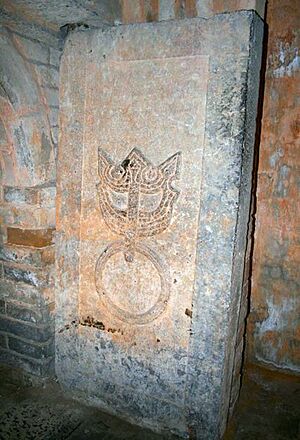
Liu Zhang of Yi Province was worried about attacks from Zhang Lu and Cao Cao. He invited Liu Bei to his territory to help defend him. Liu Bei's advisor urged him to take control of Yi Province instead. Liu Bei agreed and led his army into Yi Province, where Liu Zhang welcomed him. Liu Zhang sent Liu Bei to defend against Zhang Lu.
In 212, Liu Bei and Liu Zhang became enemies and started fighting. Zhuge Liang led some of Liu Bei's forces from Jing Province to help him attack Liu Zhang. Guan Yu stayed behind to defend Jing Province. In 215, Liu Bei defeated Liu Zhang's forces and surrounded him in his capital, Chengdu. Liu Zhang surrendered, and Yi Province became Liu Bei's new base. He used the mountains there as natural defenses against Cao Cao.
In the same year, Liu Bei and Sun Quan had a disagreement. Liu Bei refused to return Jing Province, which he had "borrowed" five years earlier. Sun Quan attacked Guan Yu, and much of eastern Jing Province quickly surrendered. After talks, Liu Bei agreed to give three commanderies to Sun Quan, renewing their alliance.
Yangping and Hanzhong Campaigns (215–219)
In 215, Cao Cao attacked Zhang Lu and defeated him. Zhang Lu surrendered, and his land in Hanzhong came under Cao Cao's control. Cao Cao then withdrew his armies, leaving a small force to defend Hanzhong. The next year, Cao Cao pressured Emperor Xian to give him the title "King of Wei." Over the next few years, Cao Cao lived more like an emperor and received greater honors.
In 217, Liu Bei began a campaign to take Hanzhong from Cao Cao. After Cao Cao's general was defeated and killed in 219, Cao Cao quickly arrived with more soldiers. Both sides were stuck in a stalemate. Cao Cao eventually decided to withdraw his forces, giving Hanzhong to Liu Bei. Liu Bei then declared himself "King of Hanzhong."
The Sun–Liu Alliance Breaks (219–220)
Around the time Liu Bei was attacking Hanzhong, Guan Yu also moved north from Jing Province to attack Cao Cao's city of Fancheng. Guan Yu surrounded the city, and the situation was so serious that Cao Cao even thought about moving his capital.
At the same time, Sun Quan became very angry with Guan Yu. Guan Yu had been hostile towards him several times. He had driven away Sun Quan's officials, forcefully taken food supplies, and made fun of Sun Quan when he proposed a marriage. While Guan Yu was attacking Fancheng, Sun Quan sent his general Lü Meng to attack Jing Province from the east. Lü Meng quickly conquered the province within weeks. Guan Yu's soldiers lost morale and deserted him. He was left with only about 300 men. Guan Yu was trapped and tried to break out, but he fell into an ambush and was captured. Guan Yu refused to surrender and was executed by Sun Quan. This ended the alliance between Sun Quan and Liu Bei. Sun Quan then formally submitted to Cao Cao and was given the title "Marquis of Wu." Sun Quan also urged Cao Cao to become emperor, but Cao Cao declined.
Emperor Xian Steps Down (220)
Cao Cao died in March 220. His son Cao Pi took the title "King of Wei" without waiting for Emperor Xian's approval. In late 220, Emperor Xian sent the Imperial Seal to Cao Pi. He issued an order saying he was stepping down from the throne in favor of Cao Pi. Cao Pi pretended to refuse three times but then accepted.
The Han dynasty officially ended at that moment. Cao Pi established the state of Cao Wei in its place. He moved the capital back to Luoyang. The former Emperor Xian was given the title "Duke of Shanyang."
In 221, Liu Bei declared himself emperor in Chengdu and established the state of Shu Han. Sun Quan remained a subject of Cao Pi until 222, when he declared himself king of a separate state, Wu (known as Eastern Wu in history). In 229, Sun Quan formally became emperor of Wu.
Images for kids


